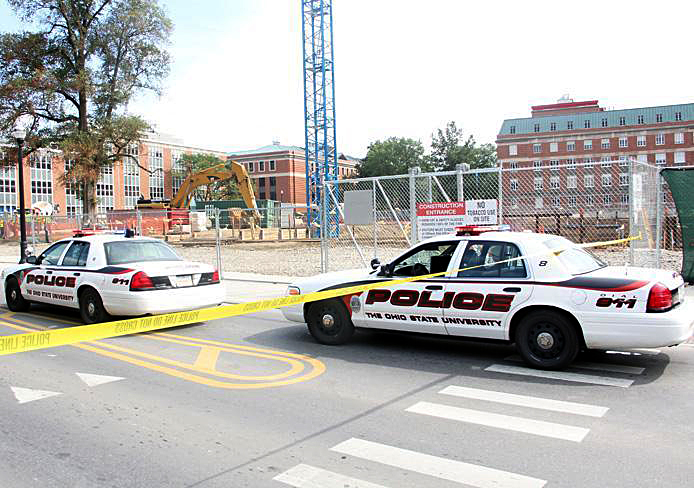
The Ohio State University Police Division recently became one of the 59 accredited college law enforcement agencies nationwide.
Credit: Daniel Chi / For The Lantern
The Ohio State University Police Division has recently been recognized as an elite player in U.S. law enforcement.
The Division became one of the 59 accredited college law enforcement agencies nationwide, a recognition less than 10 percent of the 680 college level agencies receive, according to a Division announcement in early September.
The accreditation lasts for three years, with annual reports to be submitted each year, according to a university press release.
The Commission on Accreditation for Law Enforcement Agencies, Inc., is a nonprofit organization that accredits police departments across the country and has international representation with countries including Canada and Mexico. CALEA is also responsible for developing standards and best practices for law enforcement agencies which gives a “leading edge for agencies to use” in writing and following procedural information, CALEA deputy director Craig Hartley said.
One of the main reasons departments seek accreditation is to provide “elite public safety” and avoid “paper tigers,” which means a policy that is on paper but isn’t enforced, to ensure the division is following the policies it puts forth, Hartley said.
“It’s a real testament to service,” Hartley said of OSU’s accreditation.
The CALEA accreditation process involves five steps: enrollment, self-assessment, on-site assessment, commission review and decision and maintaining compliance and reaccreditation.
The initial accreditation fee was $8,400 and the annual continuation fee for OSU will be $4,065, University Police Deputy Chief Richard Morman, who was the person in charge of orchestrating the accreditation process, said in an email.
OSU began the process in August 2010, but its involvement with CALEA started long ago.
In the late 1970s and early 1980s, CALEA selected OSU’s University Police as “Field Review Agency,” which meant OSU was essentially looked at as an example, Morman said.
It wasn’t until University Police Chief Paul Denton took over in 2006, though, that OSU began to become serious with the idea of accreditation.
“Past chiefs hadn’t worked at an accredited agency before coming to Ohio State,” Morman said. “Chief Denton came from the (Columbus Division of Police), which is accredited, and he saw the value in becoming accredited.”
Once the self-assessment phase began, OSU looked at its policies and practices to make sure they were in line with the CALEA standards.
OSU initially began revising policies by working with the Columbus Police, City of Dublin Police, Kent State University Police Services and Purdue University Police Department, all of which are already accredited, according to University Police Officer Adam Tabor, who worked with policy-writing during the process.
“More than 90 percent of the standards were already met before the accreditation process began,” Tabor said. “Accreditation bolsters support and feeling that you do have a good police organization.”
University Police is also a State of Ohio Accreditation Resources member, which provided additional resources such as reviewing the policies University Police had in place.
“We don’t feel that accreditation made us do anything we weren’t already doing,” Tabor said. “It puts a stamp of approval on what we were already doing.”
Tabor said most of the self-assessment phase involved putting together a 500-page document called the “General Orders,” which lists policies and procedures. He said a majority of that was simply writing down policies that were already in place, but weren’t in writing.
Morman agreed it was mostly a matter of getting things down on paper.
“There were plenty of things that we were already doing that met standards, but we didn’t have a written policy,” Morman said.
An example of that was the Clery Act, an early 1990s U.S. bill requiring colleges and universities to publish annual security logs, have a public crime log and issue timely warnings of crime.
Some of the biggest changes came about while writing policies for the regional campus police departments, such as OSU Lima and the Agricultural Technical Institute in Wooster. This involved developing policy which was tailored to the “uniqueness of regional officers” but still fell under the General Orders of University Police in Columbus.
After the self-assessment, CALEA visited OSU in April to verify University Police was following the 188 required standards, including use of reasonable force, search and seizure and training standards.
Tabor said much of the reasoning behind going through the three-year accreditation process was to bring in a voluntary watchdog to review the standards in place and to raise them to an international level of excellence. Accreditation also helps with liability issues, he added.
“We operate in a dangerous and fluid atmosphere where split second decisions have to be made,” he said.
By having policies in place, OSU can point to the standards put in place by CALEA as a method of reasoning.
Hartley said the accreditation represents a step forward by University Police.
“It’s absolutely a commitment by OSU to do the very best job they can possibly do, and shows a willingness to be transparent,” Hartley said. “As a student, you ought to be proud of your organization.”
Morman said the process was difficult and time-consuming, especially while still having to perform day-to-day activities, but was “definitely worth the effort.”
Tabor agreed.
“It’s part of what this university expects and appreciates,” he said.


